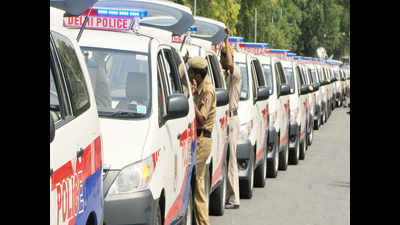- News
- City News
- delhi News
- Delhi cops save the day when medics can’t
Trending
This story is from July 11, 2019
Delhi cops save the day when medics can’t
Before a handful of CATS ambulances arrived last week at a burning building in Tigri in south Delhi, the police control room team had rescued five trapped women, provided them first aid and got them admitted in a government hospital.

Picture used for representational purpose only
NEW DELHI: Before a handful of CATS ambulances arrived last week at a burning building in Tigri in south Delhi, the police control room team had rescued five trapped women, provided them first aid and got them admitted in a government hospital.

In cases like this, the PCR vans are frequently the default option for a quick effort to save lives. The cops also act as first responders and preventers of suicides.
According to PCR officers, almost 40% of distress calls received by the control room are related to medical emergencies, including shifting of pregnant women or heart patients to hospitals.Given this role, PCR teams have been trained in basic life-saving procedures and ways to lessen the discomfort of patients.
“In areas like outer and south-west Delhi, the PCR van is a lifeline during emergencies, so we have equipped our teams with first responder kits,” said Shankar Chaudhary, additional DCP (Operations).
The control room has attended to around 50,000 calls this year, of which 19, 601 were of cases where the victim had to be shifted to hospital. In the past 10 days, the personnel have also ferried three pregnant women to hospitals after they failed to avail the CATS ambulance service due to the ongoing strike.
Once a call reaches the control room, the case is assigned to the nearest mobile unit. The van races to the scene and alerts the control room, which then passes on all information to the beat officer and the other emergency response units. It then takes 5-6 minutes for an ambulance to reach the spot. In this time, the PCR personnel assess the condition of the victim and decide on a course of action. Even before the ambulance arrives, the cops make use of the kit available with them — crepe bandages, fracture braces, cervical collars, ice packs, eye shades, among other — to make the victim comfortable. Any bleeding or injuries are also attended to before the injured people are moved to a hospital.
An assistant sub-inspector posted with a PCR in south Delhi disclosed that among all the tasks they are required to do, shifting an injured to hospital is their biggest challenge. “Very often, because of trauma, victims stop responding to stimuli even when they are capable of it,” the ASI said. “Lifting them into the vehicle takes special care since we don’t fully know about the nature of injuries. And while the driver of the vehicle has to take care to avoid potholes, the accompanying policeman may have to press a wound with his hand or a piece of cloth to stanch all bleeding and to hold the victims to prevent them from moving.”

In cases like this, the PCR vans are frequently the default option for a quick effort to save lives. The cops also act as first responders and preventers of suicides.
According to PCR officers, almost 40% of distress calls received by the control room are related to medical emergencies, including shifting of pregnant women or heart patients to hospitals.Given this role, PCR teams have been trained in basic life-saving procedures and ways to lessen the discomfort of patients.
The cops have also procured specialised equipment like cervical collars and fracture braces for on-the-spot trauma care within the golden hour of an accident. Training will now be imparted to the PCR personnel to judge and deal with the medical condition of the victims before medical help arrives.
“In areas like outer and south-west Delhi, the PCR van is a lifeline during emergencies, so we have equipped our teams with first responder kits,” said Shankar Chaudhary, additional DCP (Operations).
The control room has attended to around 50,000 calls this year, of which 19, 601 were of cases where the victim had to be shifted to hospital. In the past 10 days, the personnel have also ferried three pregnant women to hospitals after they failed to avail the CATS ambulance service due to the ongoing strike.
Once a call reaches the control room, the case is assigned to the nearest mobile unit. The van races to the scene and alerts the control room, which then passes on all information to the beat officer and the other emergency response units. It then takes 5-6 minutes for an ambulance to reach the spot. In this time, the PCR personnel assess the condition of the victim and decide on a course of action. Even before the ambulance arrives, the cops make use of the kit available with them — crepe bandages, fracture braces, cervical collars, ice packs, eye shades, among other — to make the victim comfortable. Any bleeding or injuries are also attended to before the injured people are moved to a hospital.
An assistant sub-inspector posted with a PCR in south Delhi disclosed that among all the tasks they are required to do, shifting an injured to hospital is their biggest challenge. “Very often, because of trauma, victims stop responding to stimuli even when they are capable of it,” the ASI said. “Lifting them into the vehicle takes special care since we don’t fully know about the nature of injuries. And while the driver of the vehicle has to take care to avoid potholes, the accompanying policeman may have to press a wound with his hand or a piece of cloth to stanch all bleeding and to hold the victims to prevent them from moving.”
End of Article
FOLLOW US ON SOCIAL MEDIA










